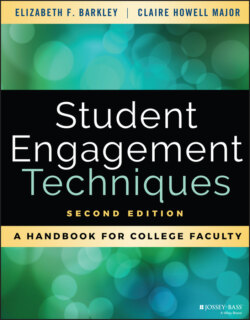Читать книгу Student Engagement Techniques - Elizabeth F. Barkley - Страница 60
Empowering Students as Partners in theLearning Process
ОглавлениеBecause optimal challenge zones are determined by an individual student's unique needs, it helps if students are empowered partners in the learning process. When students have the power to make decisions regarding their own learning, they can take steps to ensure they are working in their optimal challenge zone. Weimer (2002) identifies sharing power with students as the first of five key changes required to shift to learner-centered teaching. Her chapter on the balance of power opens with this paragraph:
How would you characterize today's college students? Empowered, confident, self-motivated learners? That is not how I would describe mine. The ones in my classes are hopeful but generally anxious and tentative. They want all classes to be easy but expect that most will be hard. They wish their major (whatever it might be) did not require math, science, or English courses. A good number will not speak in class unless called on. Most like, want, indeed need, teachers who tell them exactly what to do. Education is something done unto them. It frequently involves stress, anxiety, and other forms of discomfort. (p. 23)
Weimer's description evokes a wonderfully clear and instantly recognizable image of disengaged students. She discusses power sharing from many perspectives, including summarizing the major themes in the writings of radical, critical pedagogues such as Freire and Hooks, noting the emphasis they give to the influence of power on the motivation to learn and on learning outcomes themselves. She also observes, “teacher authority is so taken for granted that most of us are no longer aware of the extent to which we direct student learning” (p. 23) and provides ample evidence of the power differential between teacher and students in typical college classes.
In Weimer's own teaching, she observes that when it becomes clear that she is not going to tell students what to do, they begin to exercise their power tentatively and anxiously, wanting feedback and needing reinforcement in order to move forward with a bit more confidence. She then shares:
It is difficult to say precisely when it happens, but one day, quite unexpectedly, the students are engaged and involved with the course and its content. There is an energy about the class, a kind of enthusiasm. Instructional nirvana does not descend. Not everybody is involved and engaged, and some activities and assignments still bomb. But student response to my efforts to share power has been the most eloquent evidence to me that learner-centered teaching is a powerful pedagogy. (pp. 30–31)
Empowering students to be active partners in their learning requires a subtle but thorough shift in focus away from what the teacher is teaching to what and how the student is learning.
Providing students with high-quality assessment and feedback, helping students to develop metacognitive skills, and empowering students as partners in the learning process are three approaches to helping students work in their optimal challenge zone. These strategies also help create synergy by connecting active learning (students are “stretching” to learn something that is at the edge of their current understanding) and motivation (this challenge is stimulating and positive both because it is new and because it is within reach).
